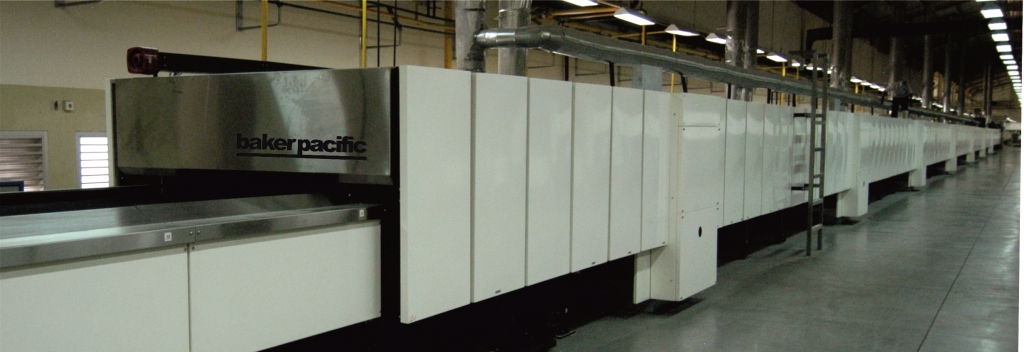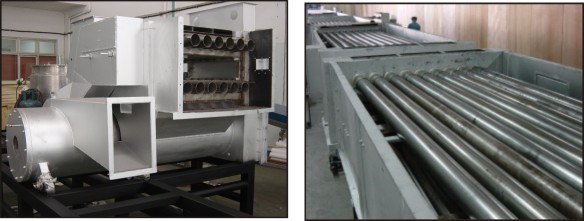Three modes of heat transfer are used for baking biscuits: radiation, conduction and convection. The most important is infrared radiation, which has the following advantages:
Penetrative heat transfer: Infrared radiation penetrates biscuit doughs by approximately 4mm, (depending on wavelength and moisture content). it is the only heat transfer mode to truly bake the product from the centre. This is the key advantage of baking by infrared radiation.
Biscuit structure: because infrared radiation penetrates the dough pieces, it is essential to achieving good structure with optimum volume and texture and is always the main mode of heat transfer in the first part of the baking process.
Even moisture content: baking with infrared radiation ensures a low moisture content from the centre to the outside surface of the biscuit. It is the best heat transfer mode to avoid “checking”, (cracks appearing in the biscuit after baking)
Efficiency: heating of the surrounding air in the baking chamber is not necessary, this lowers energy consumption
Colouring: radiation enables highlighted colour contrasts for crackers and rotary moulded products, whereas convection gives an overall, bland, even colour.
Versatile: infrared baking is suitable for all types of biscuit
Baker Pacific multi-purpose oven baking by infrared radiation
Heat transfer modes
Infrared radiation
All objects above a temperature of absolute zero radiate energy to their surroundings. The energy or radiation is emitted as electromagnetic waves, which travel at the speed of light. The waves may travel through a vacuum or other medium. When they impact an object, they are partially absorbed and partially reflected. Good emitters are also good absorbers of thermal radiation.
Infrared radiation is in the wavelength band of 0.7 – 300 microns (above visible light). Higher temperatures produce shorter wavelengths. Typical wavelengths in an Indirect Radiant oven are around 4.6 – 6.4 microns, which provides good heat penetration of the dough pieces.
Infrared radiation for baking is emitted principally by Direct Gas Fired (DGF) burner flames and by the radiant tubes in an Indirect Radiant oven.
Since the radiant energy emitted is proportional to the temperature to the power of 4, a small increase in temperature will give a large increase in radiation. This contributes to the fast response of DGF ovens.
Zone diagrams for DGF oven and Indirect Radiant oven
Conduction
Conduction transfers heat from the oven band directly to the base of the dough pieces. The heat transfer is dependent on the temperature and the heat mass of the oven band and the surface of the band in contact with the dough pieces. With steel bands and heavy mesh bands this approximates to full contact and is very effective.
Ovens with band pre-heat can quickly transfer heat into the base of the dough pieces and achieve rapid development of the biscuit structure and texture; this is particularly valuable for soda cracker baking.
Cracker baking oven with band pre-heat burners below the return band circuit
Convection
Convection baking uses hot air jets which impinge directly on top of the dough pieces and on to the underside of the oven band. This system effectively dries and colours the surface of the dough pieces. However it produces a hard dry skin on the dough pieces and will prevent good expansion and “lift” of the product if used at the start of the baking process. Also it is a cause of moisture gradient between the surface (very dry) and the centre of the biscuit (more moist). This may result in “checking”, (cracking of the biscuits after baking), unless the moisture gradient is reduced after baking.
Direct convection oven zone
Infrared Radiant Ovens: Direct Gas Fired Ovens

DGF ovens bake with infrared radiation. High rate burners enable rapid baking of crackers with excellent “lift”, open and flaky texture. For cracker baking, pre-heat burners also increase conduction to the dough pieces in the first oven zone.
Eratec high rate infrared burners with gas/air mixer and Siemens solenoid valve / zero governor in a Baker Pacific cracker oven
Indirect Infrared Radiant Oven

Indirect ovens provide fuel security as gas or oil can be used. The burners fire into a heat exchanger and the hot air is circulated through radiant tubes above and below the baking band. Baking is by infrared radiant from these radiant tubes.
The heating system is essentially a closed system, in which the hot air and burned gas is circulating. The energy required from the burner is only that which is needed to maintain the baking temperature.
The burner draws in air for combustion and the excess is exhausted by a natural flue (without fan). This hot air / burned gas can be used in a heat recovery system and this ensures a high fuel efficiency.
Heat exchanger and radiant tubes installed in a baking chamber










